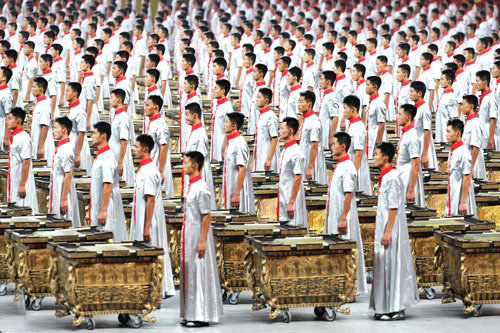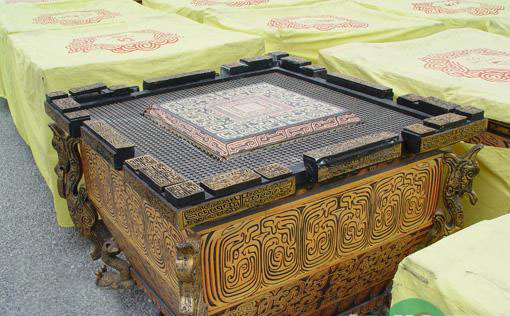foss of the olympic opening ceremony
In the thunderous sound of fouling, the audience shouted together with the change of numbers: "10, 9, 8, 7, 6, 5, 4, 3, 2, 1" The moment when the opening ceremony officially started: 20:00.
In 2008, the actors sang and recited "It is a joy to have friends from afar", expressing their warm welcome to the Olympic athletes and guests from all over the world.

From the perspective of the development and evolution of the can, the "fo" used in the opening ceremony of the Olympic Games is quite different from the original appearance of the "fo". However, from the point of view of the on-site effect, the formation of acousto-optic high-tech collection, the effect is very brilliant. In particular, the digital countdown is played by the light on the face of the can, which is a bit of a magic touch.
The majestic 2008 people's fǒu array at the opening ceremony sounded like they were beating a drum, and the shape of this musical instrument originated from the bronze Jian Fou unearthed in the tomb of Zenghou Yi in Suizhou, Hubei in 1978. According to the ancient Chinese "octave classification", musical instruments are divided into eight categories: gold, stone, earth, leather, silk, bamboo, bamboo, and wood. As an ancient Chinese earthen instrument, the sound of the fu is never the same as that of the drum, which is a leather musical instrument, and its shape is completely different from the above-mentioned bronze Jian fu. "Jian Fou" is not a Fou, and there is no record of "Fou Formation" in ancient music literature. As an ancient musical instrument, what does the fu look like? Archaeological finds have already given the answer. In 2004, during the excavation of the tomb of the Yue Kingdom nobles in Hongshan, Wuxi, archaeologists found a burial pit composed of more than 500 combined musical instruments in the niche of the large tomb, among which there were three pot-shaped celadon musical instruments. According to functional classification and experts, this is the "Fou" that Qin Wang was forced to strike at the Mianchi meeting. The ancient musical instrument celadon can in the picture has a diameter of 40 cm and a height of 24.2 cm. The inside and outside are covered with blue-yellow glaze. The brim and upper abdomen are decorated with fine pancreas patterns. On the edge of the mouth, the two forelimbs of the lizard climb on the edge, and the mouth holds the edge of the can, and the shape is exaggerated and vivid.

The prototype of the 2008 musical instruments in the "Fou Array" - Zeng Houyi's bronze Jian Fou, is actually a combination device, which is made of bronze Jian and bronze cans. The jacket is the mirror, and the can is in it. There is a large space between the outer wall of the can and the inner wall of the mirror. It has the dual functions of cooling and heating the wine pulp. Some experts call it the earliest ancient "refrigerator" ( Of course it should also be "warm box"). This special bronze wine vessel, in terms of shape and material, has nothing to do with the clay musical instrument Fufeng Ma Niu.
 渝公网安备 50010702504639号
渝公网安备 50010702504639号